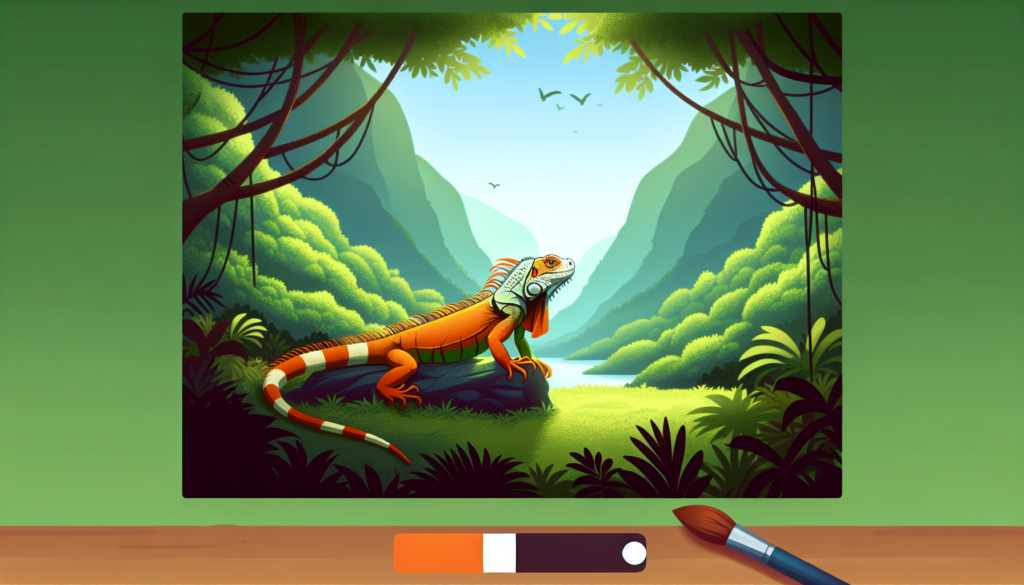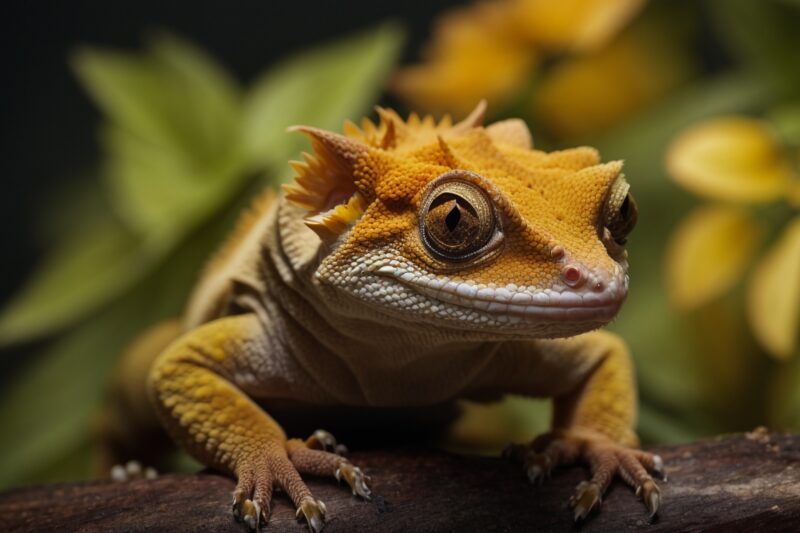Are you ready to embark on an exciting adventure with the Orange Iguana? In “The Orange Iguana’s Quest”, get ready to witness the remarkable journey of an extraordinary orange green iguana as it sets out to uncover the secrets of its world. Brace yourself for a captivating tale filled with thrilling encounters, breathtaking landscapes, and unexpected twists. This is a quest that will ignite your curiosity and leave you in awe of the remarkable abilities of this unique creature. Get ready for an unforgettable adventure that will transport you to a world unlike anything you’ve ever seen before.

Overview
Welcome to the comprehensive guide on the majestic Orange Iguana! In this article, we will delve deep into the background, habitat, physical characteristics, behavior, threats, conservation efforts, unique adaptations, research and discoveries, interactions with humans, and more. Get ready to embark on a fascinating journey to explore the world of the Orange Iguana.
Background of the Orange Iguana
The Orange Iguana, scientifically known as Iguana orangensis, is a fascinating reptile native to the lush rainforests of Central and South America. This magnificent creature is a member of the iguana family, characterized by its vibrant orange coloration and distinctive physical features. While closely related to the common green iguana, the Orange Iguana has its own unique characteristics that set it apart.
Habitat and Distribution
Orange Iguanas are primarily found in the tropical rainforests of Central and South America, including countries such as Costa Rica, Panama, Colombia, and Ecuador. These regions provide the ideal habitat for these reptiles, with their dense vegetation, ample food sources, and thriving ecosystems. The iguanas can also be spotted in the surrounding areas, including lowland forests, riverbanks, and even secondary forests.
Physical Characteristics
One of the most striking features of the Orange Iguana is its vibrant orange coloration. The adult males sport a vivid orange hue, while the females and younger iguanas display a more subdued orange tone with hints of greenish undertones. This unique coloration allows them to blend seamlessly into their forested surroundings.
With an average length of 3 to 5 feet, the Orange Iguana boasts a robust and muscular body. This reptile has a long tail, which comprises almost two-thirds of its total body length. Equipped with sharp claws, the iguana is also known for its sturdy limbs, enabling it to effortlessly climb trees and maneuver through its dense rainforest environment.
Behavior and Life Cycle
Feeding Habits
Orange Iguanas are herbivorous creatures with a voracious appetite for a variety of plant matter. Their diet primarily consists of leaves, fruits, flowers, and even smaller berries. These iguanas possess specialized teeth called acrodont teeth, which help them efficiently grind and consume plant matter. Their herbivorous diet plays a crucial role in seed dispersal, aiding in the growth and regeneration of the rainforest ecosystem.
Reproduction and Courtship
During the breeding season, which typically occurs during the rainy months, male Orange Iguanas engage in elaborate courtship displays to attract females. They bob their heads, extend their brightly colored dewlaps, and perform impressive push-up displays to showcase their strength and dominance. Once a female is enticed, mating occurs, and she will then lay her eggs in nests dug in the soil. The nests provide a safe and warm environment for the eggs to develop.
Social Structure and Communication
Orange Iguanas are primarily solitary creatures, and interactions among individuals are limited to courtship and mating rituals. They communicate through visual displays, such as head bobbing and color changes, as well as through body movements and sometimes vocalizations. These communication methods play a vital role in establishing dominance, signaling aggression, or attracting mates.
Threats and Conservation
Hunting and Illegal Trade
Despite their captivating presence, Orange Iguanas face numerous threats in the wild, primarily due to humans. Hunting for their meat, skin, and exploitation in the illegal pet trade pose significant risks to their survival. Poaching and trafficking of these beautiful reptiles not only deplete their numbers but also disrupt the delicate balance of their natural habitat.
Habitat Loss
The destruction and fragmentation of their rainforest habitat also pose a significant threat to Orange Iguanas. Deforestation, primarily driven by commercial agriculture, logging, and urbanization, deprives these reptiles of their homes and disrupts their foraging and reproductive behaviors. The loss of vital trees and vegetation also indirectly impacts their prey availability, leading to potential population decline.
Conservation Efforts
Thankfully, there are ongoing conservation efforts to protect the Orange Iguana and its precious habitat. National and international organizations are working alongside local communities, governments, and scientists to raise awareness, enforce anti-poaching laws, and promote sustainable land-use practices. These conservation initiatives play a crucial role in safeguarding the future of these captivating reptiles.
Unique Adaptations
Coloration and Camouflage
One of the most remarkable adaptations of the Orange Iguana is its vibrant orange coloration, which serves as an effective camouflage mechanism. The bright orange hue allows them to blend seamlessly into the green foliage of their rainforest habitat. This remarkable adaptation helps them evade predators and remain unseen while they bask in the warm sunlight or when they are foraging for food.
Tail Functionality
The long and robust tail of the Orange Iguana serves multiple purposes. Not only does it aid in balancing while climbing trees, but it also functions as a defensive mechanism. When threatened, these iguanas can whip their tails with great force, delivering a powerful strike to potential predators. Additionally, their tails also serve as an energy reservoir, allowing them to store fat and nutrients during times of scarcity.

Research and Discoveries
Scientific Studies and Findings
Scientific studies on the Orange Iguana have revealed fascinating insights into their behavior, ecology, and evolutionary history. Researchers have been able to better understand their population dynamics, habitat preferences, and the impact of human activities on their survival. Furthermore, cutting-edge technologies, such as DNA analysis and satellite tracking, have provided valuable data for conservation strategies.
Newly Discovered Species
In recent years, several new species of Orange Iguanas have been discovered, adding to the diversity and intrigue surrounding these reptiles. These newfound species have unique characteristics, genetic differences, and ecological preferences, shedding light on the complexity and richness of the tropical rainforest ecosystems they call home. The discovery of these species highlights the need for further research and conservation efforts.
Interactions with Humans
Cultural Significance
Orange Iguanas have significant cultural significance in the regions where they are found. Indigenous communities often depict them in their traditional stories, folklore, and even artwork. These reptiles are revered as symbols of strength, wisdom, and balance, showcasing the deep connection between humans and the natural world.
Human-Iguana Conflicts
As human populations expand and encroach upon the natural habitat of the Orange Iguanas, conflicts can arise. These conflicts often stem from competition for resources, such as food and suitable nesting sites. However, through education, sustainable land-use practices, and community involvement, these conflicts can be mitigated, promoting coexistence between humans and the iguanas.
Iguanas as Pets
While the allure of owning an Orange Iguana as a pet is understandable, it is important to consider the potential impacts on both the individual and wild populations. Captive iguanas require specialized care, including a proper diet, adequate space, and environmental enrichment. Additionally, the demand for these reptiles in the pet trade can contribute to their illegal capture and trafficking. Responsible ownership and supporting reputable breeders are essential in promoting ethical practices.
Conservation Methods
Protected Areas and Reserves
Creating protected areas and reserves is a crucial step in safeguarding the habitats of Orange Iguanas and other threatened species. These designated areas provide legal protection against habitat destruction, poaching, and unsustainable land-use practices. Collaborative efforts between government agencies, non-profit organizations, and local communities are vital in establishing and effectively managing these protected areas for long-term conservation.
Community Involvement
Engaging and involving local communities in conservation efforts is key to the success of conservation initiatives. By providing educational programs, livelihood opportunities, and promoting sustainable practices, communities become stewards of their natural environment. Empowering local communities to actively participate in conservation promotes a sense of ownership and responsibility, ensuring the long-term survival of the Orange Iguana and its habitat.
Promoting Awareness
Raising public awareness about the plight of the Orange Iguana and the importance of conservation is crucial in inspiring action. Through educational campaigns, outreach programs, and media platforms, individuals can learn about the challenges these reptiles face and the actions they can take to contribute to their protection. By fostering a collective understanding and appreciation, we can actively work towards a sustainable future for the Orange Iguana.
Threatened Iguana Species
IUCN Red List Categories and Examples
Several species of iguanas, including the Orange Iguana, are currently listed on the IUCN Red List as threatened or endangered. These classifications indicate the precarious state of these reptiles and the urgent need for conservation efforts. Examples of threatened iguana species include the Galapagos marine iguana, Fiji banded iguana, and Lesser Antillean iguana.
Conservation Challenges
Conserving iguanas, including the Orange Iguana, presents numerous challenges due to habitat degradation, poaching, and the complex dynamics of their ecosystems. Limited funding, lack of awareness, and entrenched societal practices also pose obstacles to their conservation. However, by collaborating with stakeholders, implementing rigorous monitoring programs, and tackling the root causes, these challenges can be overcome.
Conclusion
In conclusion, the Orange Iguana is not only a stunning reptile but also a vital component of the rich rainforest ecosystems it inhabits. From their vibrant coloration, unique adaptations, and complex behaviors to the threats they face and the conservation efforts being made, the Orange Iguana embodies the delicate balance between humans and nature. By understanding, appreciating, and actively supporting their conservation, we can ensure a future where these remarkable creatures thrive in their natural habitat for generations to come. So let us cherish and protect the Orange Iguana and the many wonders of our natural world.
